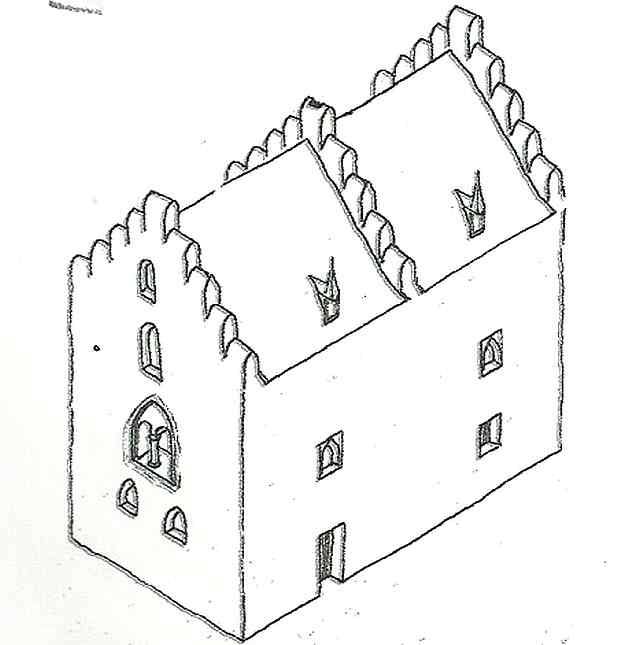5. Two-Bay House
Built in the 13th century
Vicarage "St. Johannes Evangelist and
St.Catharina". In 1609 the two bay
windows were added to the gothic
semi-detached house.
The building’s name goes back to the annex of the two bays to the gothic semi-detached house in 1609. The main building, with the crow-stepped gable, belongs to the semi-detached house from the 13th century, whose other half is the "gothic house". The house used to be a canon's house and, following its secularisation in 1802, was sold from French governmental-owned property to private ownership.
We are standing in front of the right wing of a double house, the "Zweierkerhaus".

The left wing is the "Gothic House". The extension of the house, which gave the building its name, dates from 1609. Since the 19th century, painters, draughtsmen, photographers and, as in the picture below, students of arts and crafts have gathered in front of the bay windows, to document them.


Detailed investigations in the "Gothic House" have confirmed that the double house was built in the 13th century. It is not known when the duplex house was divided.
In the records, only the right half of the double house, the “Zweierkerhaus“ is called the vicarage house. The assignment oft he house to the altar of "St. John Evangelist and St. Catharina" took place from 1660, when the two previously separate altars were combined in the tower chapel of the collegiate church. The altar of St John the Evangelist had been donated by Archbishop Balduin in 1323. The donation was made in memory of the imperial brother Henry VII. The Catharine altar was first mentioned in 1308. In 1791, the vicar of the double altar, which had existed since 1660, had to say two annual masses, one monthly mass and two weekly masses from the foundations dedicated to him.
Johann Mathias Plein from Mayen, the penultimate vicar of the altar "St. John the Evangelist and St. Catharina", lived in the Zweierkerhaus from 1739-1788. After the death of Plein, the canon Jacob Zunder took over the house. Johann Jakob Zunder was canon from 1773-1802.
After the abolition of the monastery, he received a pension from the French state and became involved in the town council for the new masters. When the new French administration was celebrated with a procession in 1798, the monastery clergy had unitedly taken part in the procession.
Most of the 13 canons and 8 vicars received a pension from the French treasury. The former clergymen were involved in the auction of the Abbey property. Some of them also made themselves politically available to the new masters. The mayor of Münstermaifeld, Jacob Schmitt, was vicar of the St. Cross and St. Matthias altars from 1788-1802. He ordered the demolition and sale of the cloister in 1810. Johann Heinrich Sevenich, vicar 1792-1802, worked as tax collector in Mertloch. The canon Johann Friedrich Luxem became mayor and postmaster in Polch. Johann Baptist Delfosse, also a former vicar, was tax collector in Münstermaifeld 1802-1814.
Like the former collegiate clergy, the population of the town did not seem to have had any major problems with the annexation to revolutionary France. The ties and dependencies of life under the archbishop's "crook" dissolved as if by magic.
Glossary
Balduin
Archbishop and Elector of Trier (1307-1354). Balduin from the House of Luxembourg, brother of the German king and Roman emperor Henry VII. (1308-1313) was one of the most influential imperial princes in the first half of the 14th century. During his reign, Münstermaifeld became an outpost of the Trier archbishop's territorial policy. Thus, the energetic promotion of the construction of the collegiate church was also a demonstration of Trier's presence vis-à-vis neighbouring Cologne. The completion of the town fortifications confirmed the importance of the Münstermaifeld office in securing the archbishop's rule. The enforcement of the land peace protected urban development against encroachments by the nobility.
Henry VII
King and Emperor (1308-1313). Henry VII had set out on a campaign in Italy in 1310, accompanied by his brother Balduin, Archbishop of Trier. His aim was to restore his rule over imperial Italy and to be crowned emperor. He achieved the imperial coronation on 29.06.1312 in the Lateran Basilica in Rome. Henry VII fell ill with malaria during the siege of Siena the following year. He died on 24.08.1313. His tomb is in Pisa Cathedral. His brother, Archbishop Balduin, had returned to Trier six months earlier.
Canon
The governing body of the monastery was the chapter, the assembly of the canons. Numerous conditions had to be fulfilled to become a full member. Ordination to the priesthood was not one of the requirements for admission to the chapter. The canon's official position was called prebend or prebend. The number of resident canons varied between 12 and 16. Only members of the chapter could become holders of special dignity and responsibility, such as dean or scholaster. Recommendations for admission as canons came from the archbishop, the pope or also the king.
Vicar
The vicars had the task of saying the endowed masses and annual memorial for the deceased at the altars assigned to them. Their number depended on the number of altars. There is evidence of a total of 27 altars. When several altars were merged in 1660, the number of vicars also decreased. In the administration of their goods and income, the vicars were subordinate to the chapter.



